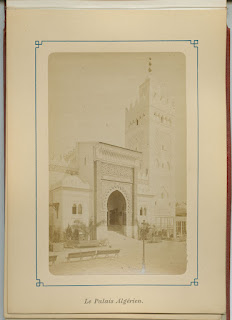With the “Arab Spring” in the headlines over the past year, many people have needed a look at the map to figure out where these events were occurring. A quick Google search might start to fill us in nowadays, but how knowledgeable were people in the past about the world outside the United States, and where did they get this knowledge?
A common way was to attend or see souvenirs from a World’s Fair. The Library Company holds a rich collection of ephemera relating to World’s Fairs, not only the Philadelphia Centennial Exhibition of 1876, but others as well. The Fairs generally showcased particular countries, along with exhibits devoted to scientific advances and new industrial processes.
 | |
| A variety of Egyptian artifacts on display at the Centennial Exhibition in Philadelphia. |
Examining photographs of the country displays reveals that visitors could see a range of artifacts, from musical instruments, to saddles, and even the door of a mosque.
 |
| Centennial Exhibition, Philadelphia. 1876. (Philadelphia, 1876). |
World’s Fairs also built sections with architecture representing different countries in the world. The Centennial Exhibition featured both an Egyptian and a Tunisian section, with characteristic edifices.
 |
| Souvenir de L'Exposition Universelle 1878 (Paris, 1878). [Gift of Michael Zinman] |
The Exposition Universelle in Paris had an Algerian Palace,
 |
| Philadelphia. The birthplace of liberty. Official souvenir view book Sesqui-Centennial International Exposition (Philadelphia, 1926). [Gift of Michael Zinman] |
while the American Sesquicentennial included “A Bit of Cairo.”
The French fair even included life-size figurines, like this “Moroccan cavalier.”
 |
| Memorial of the International Exhibition 1876. 48 Views. [Gift of Michael Zinman] |
In the second half of the 19th Century, Cook’s took advantage of railways and the lower cost of travel to extend the European Grand Tour to more middle class customers, and to add destinations in the recently colonized Middle East.
 |
| Emerson, Smith & Co., L'td., saw manufacturers (Beaver Falls, PA, 1886) and French Spy (Philadelphia, 1865) [Gift of Helen Beitler and Estate of Helen Beitler] |
Of course, a grand tour was out of the reach of many pocketbooks, but familiarity with world events and other cultures is evident in consumer products and popular entertainment as well. A trade card features a curved dagger, and bears the words Damascus Temper. Blades forged in Damascus were renowned for their strength and sharpness, but also bore a particular pattern, reminiscent of Damask cloth. A label, possibly from tobacco, is emblazoned “French Spy,” which most likely refers to a play by J. T. Haines. Also entitled “The Siege of Constantina” or “The Fall of Algiers,” this oft-performed work owed some of its popularity to the fact that the title character was played by a woman, whose bare legs were visible onstage in her “Arab” costume.
These images are all drawn from a current NEH-funded digitization project, focusing on ephemera. Such comparatively everyday items open a unique window on the past and allow us to gain a better understanding of the lived experience of our forebears, without access to their Facebook pages or Twitter updates.
Edith Mulhern
Digitization and Reference Assistant
Edith Mulhern
Digitization and Reference Assistant














